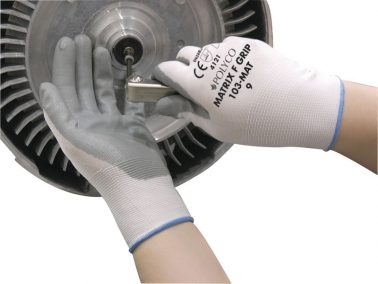Hand Protection at Work
 There are many ways in which your hands can be at risk of injury in the workplace. You may think this is only a problem for people involved in manual labour – for example, on a construction site – but different working environments can contain different hazards. For example, if you use your hands to do a repetitive job such as working on an assembly line, typing at a keyboard, operating machinery by hand, over time, you may suffer from repetitive strain injury (RSI). This musculoskeletal disorder can cause pain and extreme discomfort in affected muscles, tendons and nerves.
There are many ways in which your hands can be at risk of injury in the workplace. You may think this is only a problem for people involved in manual labour – for example, on a construction site – but different working environments can contain different hazards. For example, if you use your hands to do a repetitive job such as working on an assembly line, typing at a keyboard, operating machinery by hand, over time, you may suffer from repetitive strain injury (RSI). This musculoskeletal disorder can cause pain and extreme discomfort in affected muscles, tendons and nerves.
Alternatively, if you regularly operate machinery that vibrates, you are also at risk of developing hand arm vibration syndrome (HAVS), also known as vibration white finger (VWF). Remember that machinery with moving parts can cause a range of injuries if mishandled, including cuts and bruises, punctures and sprains, as well as problems that are more serious that could endanger limbs.
In a laboratory or similar environments, if you are handling chemicals, you may be at risk of burns and of developing dermatitis or other skin conditions. Damage to your wrist bones may result in carpal tunnel syndrome (CTS), and many hand injuries have unpleasant long-term effects.
Prevention
It makes sense to protect your hands at work, no matter what sort of job you do. There are many types of hand protection available to prevent serious damage, and it’s important to get into the habit of taking precautions every time you are carrying out a duty that puts you at risk. Specialist gloves will help you protect yourself, and there are different types available for people working with electricity, chemicals, syringes, mechanical devices and welding equipment, to name a few. Some gloves are heat resistant and others are specially designed and manufactured to prevent cuts. In certain cases, additional reinforcements are added to protect the back of the hand, which can be particularly vulnerable.
Employers should encourage people working at a keyboard to be mindful of maintaining good posture. One solution is to offer employees the option to use a wrist rest and an adjustable footrest, as this can help to prevent RSI. A chair that has good lumbar support is also important.
Knowledge and information
Training for employees is a vital part of health and safety in the workplace, and it’s imperative that employers are diligent in this respect. Employers have a responsibility to keep people safe in the workplace, so they should use everything at their disposal to reinforce key safety messages, including disclosing the appropriate information and displaying clear signage in respect of hazards, such as very hot water in washrooms and dangerous substances in designated areas.
Preventing injuries to your hands is also a personal responsibility, so if employees feel that the workplace is inadequate in some respect, they should bring this to the attention of their employers. For example, workers may feel that they need protective clothing, additional training or extra equipment and, if so, they should alert their employers and ask them to supply what is required.
Take a look at our free expert guide on How to handle first aid for burns in 13 easy steps.
